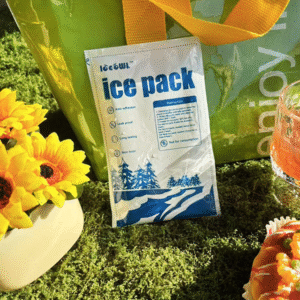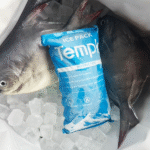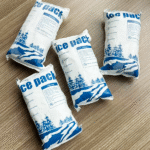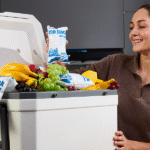If you need deep-cold reliability without the waste, gel dry ice packs give you long hold times with simpler handling. You get fewer excursions, cleaner paperwork, and easier returns. The goal is practical performance: right-size coolant load, prevent freezing risks, und treffen 2025 packaging rules with reusable shells and PFAS-free films.
-
Wie gel dry ice packs extend hold time while reducing coolant mass on −20 °C and −80 °C lanes.
-
Wann gel dry ice packs beat loose pellets for safety, Handhabung, and pack-out repeatability.
-
Wie zu Größe gel dry ice packs for 24–120 hours using simple heat-load math and SOP checklists.
-
Wo gel dry ice packs fit against PCMs for +2 ° C bis +8 °C shipments and mixed networks.
-
How to build a reuse loop with gel dry ice packs that lowers cost and waste.
What are gel dry ice packs and why do they matter?
Direkte Antwort: Gel dry ice packs encapsulate dry ice within a permeable gel matrix or engineered pouch that controls sublimation and contact. They deliver deep-freeze performance with fewer hot spots, Sicherer Handling, and more repeatable pack-outs than loose pellets. You avoid direct pellet-to-vial contact while maintaining −78.5 °C capability.
Erläuterung: Think of loose pellets like marbles that roll and create contact points. Gel dry ice packs act like cushions that spread the cold. They enable consistent loading patterns, reduce “cold shock,” and simplify training. For teams scaling across hubs, repeatable pack-outs with gel dry ice packs shorten onboarding and cut variance in real lanes.
How gel dry ice packs compare to pellets and slabs
Deeper detail: Loose pellets cool fast but shift during transit. Slabs cool evenly but can be bulky and hard to fit around odd shapes. Gel dry ice packs sit between the two: better contact control than pellets, more flexible than slabs, and easier to handle in small workspaces. They also streamline documentation, because weight per pack is standardized.
| Anwendungsfall | Pellets | Slabs | Gel Dry Ice Packs | Was es für Sie bedeutet |
|---|---|---|---|---|
| Shape conformity | High but unstable | Niedrig | Medium-High | Gel dry ice packs contour without rolling; fewer re-packs. |
| Pack-out speed | Medium | Niedrig | Hoch | Standardized units cut training time and errors. |
| Contact risk | Höher | Low-Medium | Niedrig | Fewer freeze spots on sensitive payloads. |
| Vented safety | Requires checks | Requires checks | Built-in flow paths | Easier SOP for CO₂ venting. |
| Count/weight control | Messy | Einfach | Very simple | Each pack has known net weight. |
Practical tips you can apply now
-
Standardize on three sizes of gel dry ice packs to cover 24 H, 72 H, Und 120 h profiles.
-
Pre-cool packs and the liner; you’ll reduce initial load by ~5–10% in stable lanes.
-
Keep a 1.25× safety factor for long customs dwell or summer tarmac.
-
For fragile biologics, place a thin buffer pad between payload and gel dry ice packs.
Schnappschuss des Falles: A specialty foods exporter moved from pellets to gel dry ice packs for multi-stop routes. The team cut pack-out time by a third, improved net-weight accuracy, and reduced re-shipments in summer peaks.
How to size gel dry ice packs for your lane?
Direkte Antwort: Calculate heat load, then match the sublimation energy of gel dry ice packs to your duration profile. Right-sized gel dry ice packs beat “just add more” because mass inflates cost, EPR fees, and emissions without extending time proportionally.
Erläuterung: Estimate heat gain through your shipper (UA), add payload buffering, and multiply by hours and average ΔT. Dry ice sublimation provides ≈571 kJ/kg. Convert total heat load into required kilograms, then divide by pack size to get the count. Round up to whole packs for consistent SOPs.
Copy-ready calculator block (use in your SOP)
Pack-out checklist for gel dry ice packs
-
Inspect vent holes and lid gaps; never seal CO₂ in a tight liner.
-
Pre-condition shipper, Nutzlast, Und gel dry ice packs for 30–60 minutes in a cool room.
-
Load packs evenly around the payload; avoid direct contact with fragile containers.
-
Mark outer carton with “UN1845” and net dry-ice weight; record on the waybill.
-
Photograph final arrangement for training and claims support.
| Sizing Input | Typical Value | Warum ist es wichtig | Für dich |
|---|---|---|---|
| UA (W/°C) | 2–8 (mid-size shipper) | Defines heat leak | Lower UA = fewer gel dry ice packs benötigt. |
| Average ΔT (°C) | 20–40 | Drives load | Hotter lanes require more coolant. |
| Safety factor | 1.15–1.30 | Dwell unknowns | Verwenden 1.25 for international air. |
| Pack net kg | 0.5–2.0 | Standardized unit | Simplifies count and labeling. |
Field-ready validation steps
-
Run a 48–72 h chamber test using your worst-case ambient profile.
-
Log internal temps at 1–5 min intervals at pack-out, mid-lane, and end.
-
Review film integrity after thaw; confirm no gel residue on payload.
-
Adjust gel dry ice packs count by ±1 pack based on margin to spec.
Gel dry ice packs vs PCMs: what should you choose?
Direkte Antwort: Verwenden gel dry ice packs for −80 °C and −20 °C lanes or when you must protect against prolonged hot dwell. Choose PCMs for +2 ° C bis +8 °C vaccines or foods that must nicht einfrieren. Gel dry ice packs are excellent when you need deep-cold and simple documents.
Erläuterung: PCMs hold a precise setpoint and are reusable. But deep-cold products and long lanes still favor gel dry ice packs because of energy density and global availability. Some networks blend both: PCM legs domestically, gel dry ice packs for international segments.
Your quick decision guide
-
Target ≤ −20 °C for 48–120 h? Wählen gel dry ice packs with a fiber shipper.
-
Ziel +2 ° C bis +8 °C? Choose bio-based PCMs; avoid dry-ice contact.
-
Uncertain last-mile dwell? Combine PCMs with a small buffer of gel dry ice packs.
-
Fragile vials? Add a spacer pad between payload and gel dry ice packs.
| Kriterium | Gel Dry Ice Packs | PCMs | What to do |
|---|---|---|---|
| Deep-cold (≤ −20 °C) | Am besten | Weak | Use gel packs; standardize counts. |
| Fridge range (+2 ° C bis +8 °C) | Gefrierrisiko | Am besten | Verwenden Sie PCMs; avoid dry ice. |
| Dokumente & Beschriftung | UN1845 & Entlüftung | Fewer labels | Pick gel for deep-cold; PCMs for fridge. |
| Reuse potential | Medium-High | Hoch | Reuse both; track cycles. |
Safety and compliance: get it right every time
Direkte Antwort: Gel dry ice packs muss co₂ entlüften, carry UN1845 marks, and list net dry-ice weight on the waybill. Use mono-material films and recycled-content shells to align with 2025 packaging rules. Keep PFAS-free materials on file for audits.
Erläuterung: The controlled form of gel dry ice packs helps with safe handling and predictable sublimation. But safety still depends on venting, Platzierung, und Dokumentation. Train every pack-out operator with the same steps, Bilder, and sign-offs.
Compliance snapshot you can share internally
| Topic | Was es bedeutet | Your action |
|---|---|---|
| UN1845 labeling | Declare “Carbon dioxide, solid” and net kg | Pre-print labels; record on waybill |
| Entlüftung | CO₂ must escape safely | Keep lid gaps/vents unobstructed |
| Packaging rules (2025) | Leichter, recycelbar, PFAS-free | Choose mono-material films and fiber shells |
| Operator variation | Airlines differ | Check the flight’s specific instructions |
Documentation block (paste into SOP)
Can gel dry ice packs reduce cost and emissions?
Direkte Antwort: Yes—if you right-size the load and reuse the outer kit. Gel dry ice packs reduce product loss and re-shipments, which is where much of the footprint hides. Standardized pack counts also cut training time and errors.
Erläuterung: Dry ice often comes from captured CO₂ streams; the system impact depends on energy for capture, Kompression, and pelletizing. The fastest wins are operational: fewer excursions, lighter shippers, and higher return rates. Gel dry ice packs help on all three by being modular, countable, and easy to stage.
Metrics that prove “eco-friendly”
-
Excursions (%): Each percentage point avoided saves replacement cost and emissions.
-
Coolant kg per delivery: Lower mass with the same duration shows good sizing.
-
Pack-out time (min): Shorter time, fewer mistakes, higher throughput.
-
Return rate (%): More cycles per shipper = lower per-use footprint.
Building a reuse loop around gel dry ice packs
Direkte Antwort: Design your program for 5–20 cycles per shell and liner. Gel dry ice packs support reuse because units are sealed, neat, and easy to inspect after thaw.
Erläuterung: Start with one region to learn returns. Use scannable codes, prepaid labels, and reminders 24–48 h after delivery. Track cycle counts and retire kits proactively. Engineer the liner to collapse flat, and specify films that survive condensation without delaminating.
Reuse math you can run today
Tips that raise cycle counts
-
Keep sizes simple: klein, Medium, groß.
-
Add a “no-ice return” line in the instructions.
-
Offer a reusable-kit discount to B2B accounts.
-
Track damage codes to find weak points in gel dry ice packs Handhabung.
Lane design: how to tailor gel dry ice packs by sector
Direkte Antwort: Map temperature targets, dwell risks, and handling limits by sector. Then assign standard gel dry ice packs counts to each lane. Keep one spare pack in SOPs for summer or congested hubs.
Erläuterung: Essen, clinical, and biotech lanes differ in acceptable temperature bands and labeling strictness. Use the same playbook structure but maintain sector-specific notes. That keeps training universal while respecting constraints.
Sector snapshots
-
Biotech & labs: Verwenden gel dry ice packs for frozen enzymes, reagents, and cell lines. Add a buffer pad and strict UN1845 procedures.
-
Gourmet foods & D2C: Verwenden gel dry ice packs for −20 °C pastries or ice cream. Design porch-dwell protection with extra top-layer packs.
-
Klinische Studien: Standardize photo verification of pack-out, einschließlich gel dry ice packs placement and seals.
-
Seafood exports: Pre-cool kits at staging. For multi-stop routes, sicher gel dry ice packs in corners to prevent drift.
| Sektor | Risiko | SOP tweak | Nutzen |
|---|---|---|---|
| Biotech | Freeze shock on fragile vials | Spacer pad + even load | Fewer micro-cracks, higher yield |
| D2C | Porch dwell in heat | +1 top pack in summer | Lower melt-out claims |
| Clinical | Audit intensity | Photos + weight log | Faster QMS reviews |
| Meeresfrüchte | Route changes | Corner-anchored packs | Better cold retention on detours |
2025 developments and trends shaping gel dry ice packs
Trendübersicht: Packaging rules favor lighter, recycelbar, PFAS-free designs and transparent labeling. Training standardization becomes a cost lever. Reusable programs scale as carriers and customers normalize returns. Gel dry ice packs benefit from this shift because they simplify counting, staging, and documentation while maintaining deep-cold capacity.
Neueste Fortschritte auf einen Blick
-
Standardized units: Fixed-weight gel dry ice packs reduce miscounts and speed audits.
-
Better films: PFAS-free, mono-material films withstand condensation and cold flexing.
-
Right-sizing tools: Simple heat-load calculators integrate with WMS, assigning pack counts per order.
-
Regional hubs: Pre-cool rooms and shelf-ready gel dry ice packs improve throughput and lane stability.
Market insight: Schwerer, mixed-material shippers face higher fees. The winners standardize on fewer sizes, use mono-materials, and push reuse. PCMs keep growing for fridge lanes, Aber gel dry ice packs remain the go-to for deep-cold and long dwell.
Häufige Fragen (FAQs)
Q1: Can gel dry ice packs touch my product directly?
Ja, but use a thin spacer for fragile vials or delicate packaging. This reduces local cold shock while keeping hold time strong.
Q2: How many gel dry ice packs do I need for 72 Std.?
Run the calculator with your UA and ΔT. Many mid-size shippers need 3–6 standardized packs, plus one safety pack in hot months.
Q3: Are gel dry ice packs reusable?
The outer kit is; the dry ice itself sublimates. You can reuse the shell and liner for 5–20 cycles if films remain intact and clean.
Q4: What about airline rules?
Mark UN1845 and net dry-ice weight, verify venting, and follow any operator notes. Gel dry ice packs make the weight step easier.
Q5: Do gel dry ice packs work with data loggers?
Ja. Place the probe near the payload core, away from direct pack contact, for a true payload reading.
Q6: Will gel dry ice packs freeze +2 ° C bis +8 °C products?
If they’re inside the same cavity, Ja. Use PCMs for fridge ranges to avoid freezing risk.
Q7: How do I avoid condensation damage after thaw?
Specify films with good cold-crack resistance, and allow a brief acclimation before opening.
Zusammenfassung und Empfehlungen
Schlüsselpunkte: Gel dry ice packs provide deep-cold performance with safer handling, easier counts, and stable pack-outs. Right-sizing beats overloading. Use PCMs for fridge ranges, und benutzen gel dry ice packs for −20 °C or −80 °C lanes. Design for reuse, mono-materials, and PFAS-free films to align with 2025 expectations.
Nächste Schritte: 1) Map lanes and seasonal ΔT. 2) Run the calculator and set standard counts of gel dry ice packs per lane. 3) Validate with a 48–72 h test. 4) Roll a reuse pilot with three kit sizes. 5) Train teams using the SOP blocks and photos.
Über Tempk
We design and validate cold-chain systems that balance durability and sustainability. Our team right-sizes gel dry ice packs per lane, reduces coolant mass, and raises reuse cycles with practical SOPs. Expect fewer excursions, faster pack-outs, and simpler audits across complex routes.
Aufruf zum Handeln: Ready to model your lanes and standardize gel dry ice packs? Request a 30-minute assessment to compare two candidate designs on duration, kosten, and emissions.
























